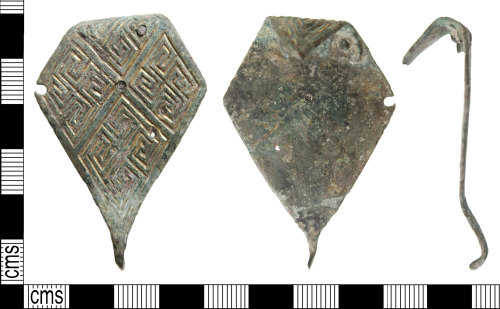
Rights Holder: Hampshire Cultural Trust
CC License: ![]()
Image use policy
Our images can be used under a CC BY attribution licence (unless stated otherwise).
BROOCH
Unique ID: HAMP-7FBF17
Object type certainty: Certain
Workflow
status: Awaiting validation ![]()
An incomplete middle early-medieval copper alloy gilt lozengiform strip brooch of Weetch type 31.C, dating to c.700-800. The brooch appears to have had some modifications during its life. The spring and pin mechanism is largely missing and the opposite end to this is bent backwards and broken across an apparently circular 1mm wide perforation at the tip.
The brooch is lozenge- or diamond-shaped with moulded decoration to one face only (the reverse being flat, smooth and undecorated).
To the front an undecorated area c.2mm wide flanks the edges of the brooch and also forms a cross saltire through the middle. This arrangement results in four lozenge-shaped areas of equal size, and within these are four angular spirals (each again creating a lozenge shape, so that four of these spirals fit within each lozenge-shaped area). At the centre of the cross saltire is a perforation 1mm in diameter, countersunk to the decorated face. There are an additional four perforations of similar diameter around this, two roughly at either edge of two opposing lozenge-shaped areas. Two of these (from the same lozenge-shaped area) retain a copper alloy rivet c.4mm long; beneath one of these is a square/ lozenge-shaped piece of rather corroded sheet copper alloy c.7x6mm. At a corner of the brooch, and extending slightly into a third lozenge-shaped area, is a worn-through perforation 2mm in diameter; there is not a corresponding perforation on its opposite corner but there is another at its neighbouring edge presumably where a catchplate might have extended (and mentioned in the first paragraph above). Three further very small perforations apparently randomly placed in decorated areas of the brooch may be intentional, damage, or a result of the casting process.
Opposite the bent edge is a projection 2.1mm wide and 1.6mm thick, turning backwards at 90 degrees where it becomes 1.1mm wide and 2.1mm thick. Its has a worn, patinated end, presumably a break but not obviously from the condition of the metal. This would have extended into a spring and pin arrangement, or perhaps a catchplate.
The metal is a mid-green in colour and largely smooth. Gilding survives in the grooves of the gem=ometric-spiral decoration. The object measures 57.3mm in length (unbent, c.70mm in length), 38.6mm in width, 1.2mm in thickness and weighs 10.05g.
A similarly-decorated lozengiform strip brooch on this database is PUBLIC-C5F154 and in the British Museum's collections http://www.britishmuseum.org/research/collection_online/collection_object_details.aspx?objectId=84853&partId=1&technique=17228&page=8&&sortBy=imageName.
Jo Ahmet comments of this brooch '[This is a] Middle Saxon brooch, c. 8th century, Weetch type 31.C, Lozengiform strip brooch. BM 1999,0102.1 seems very similar, listed in Rosie Weetch's thesis as No. 984. ... I think [this] example might have had a new catchplate and pin arrangment added at some point in its life hence the rivets. These brooches tended to have spring and catchplates formed from each of the long points' (pers. comm. August 2018).
Find of note status
This has been noted as an interesting find by the recorder.
Class:
lozengiform strip brooch
Sub class: Weetch type 31.C
Subsequent actions
Subsequent action after recording: Returned to finder
Chronology
Broad period: EARLY MEDIEVAL
Subperiod from: Middle
Period from: EARLY MEDIEVAL
Subperiod to: Middle
Period to: EARLY MEDIEVAL
Date from: Circa AD 700
Date to: Circa AD 800
Dimensions and weight
Quantity: 1
Length: 57.3 mm
Width: 38.6 mm
Thickness: 1.2 mm
Weight: 10.05 g
Discovery dates
Date(s) of discovery: Sunday 1st April 2018 - Monday 30th April 2018
Personal details
This information is restricted for your access level.
Materials and construction
Primary material: Copper alloy
Completeness: Incomplete
Surface Treatment: Gilded
Spatial metadata
Region: South West (European Region)County or Unitary authority: Wiltshire (Unitary Authority)
District: Wiltshire (Unitary Authority)
Parish or ward: Boyton (Civil Parish)
Spatial coordinates
4 Figure: ST9440
Four figure Latitude: 51.15921871
Four figure longitude: -2.08717842
1:25K map: ST9440
1:10K map: ST94SW
Grid reference source: From finder
Unmasked grid reference accurate to a 1 metre square.
References cited
| Author | Publication Year | Title | Publication Place | Publisher | Pages | Reference | |
|---|---|---|---|---|---|---|---|
| Weetch, R. | 2014 | Brooches in Late Anglo-Saxon England within a North West European context: A study of social identities between the eighth and eleventh centuries | Reading | Unpublished PhD thesis, University of Reading | 984 |
Similar objects

Find number: PUBLIC-C5F154
Object type: BROOCH
Broadperiod: EARLY MEDIEVAL
An incomplete middle early-medieval (Anglo-Saxon) lozengiform strip brooch of c. 8th-century date (Weetch Type 31.C). The brooch is of one-pi…
Workflow: Published![]()

Find number: HAMP-66F1F8
Object type: BROOCH
Broadperiod: ROMAN
A Roman (AD 43-100) copper-alloy lozenge-shaped plate brooch with hinge mechanism, missing its pin and the curl of the catchplate. All damage…
Workflow: Published![]()

Find number: SF-AA671A
Object type: BROOCH
Broadperiod: EARLY MEDIEVAL
An incomplete gilded copper alloy early medieval (Middle Anglo-Saxon) lozengiform strip brooch. The object is formed from a single piece cons…
Workflow: Awaiting validation![]()



